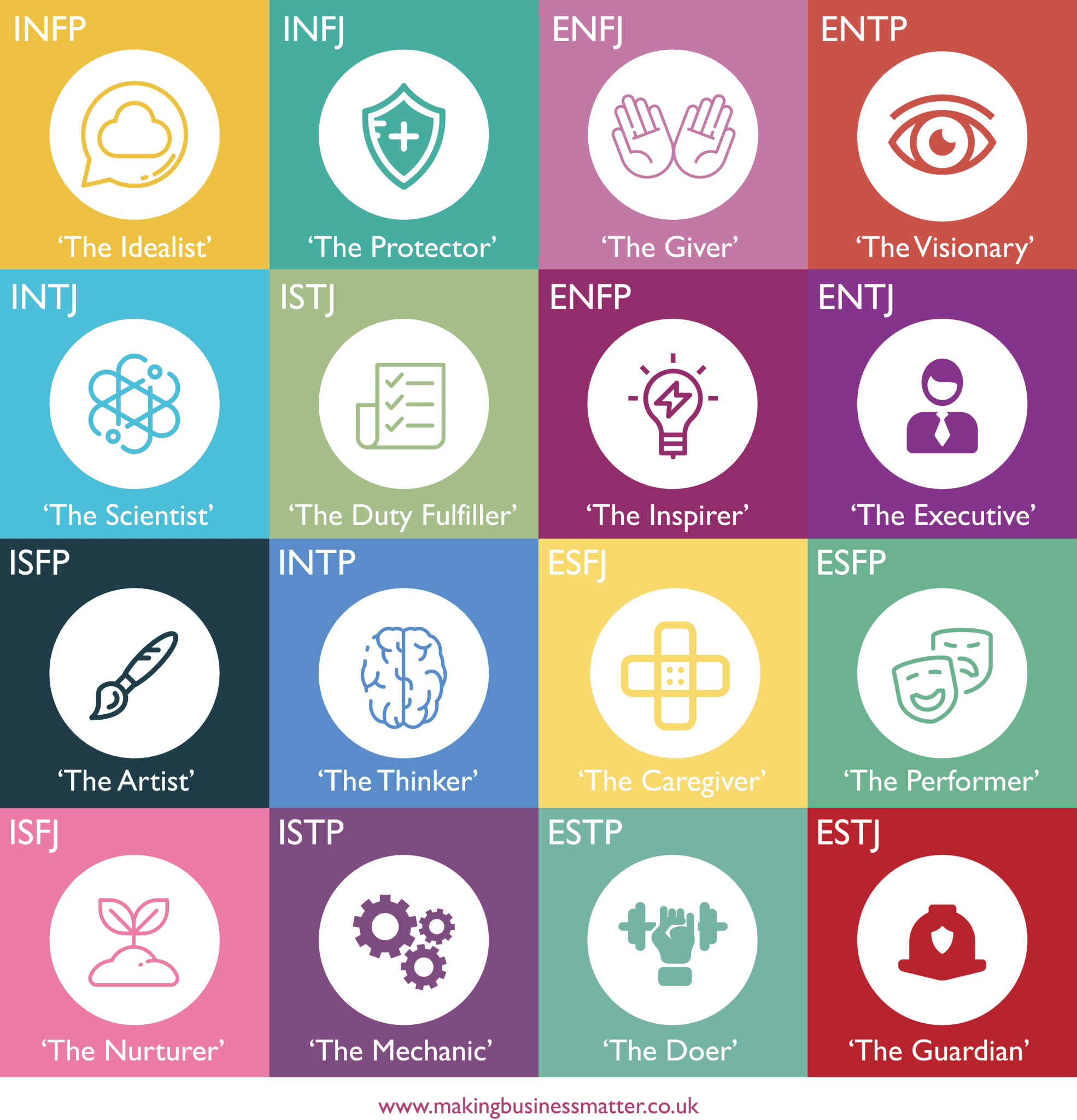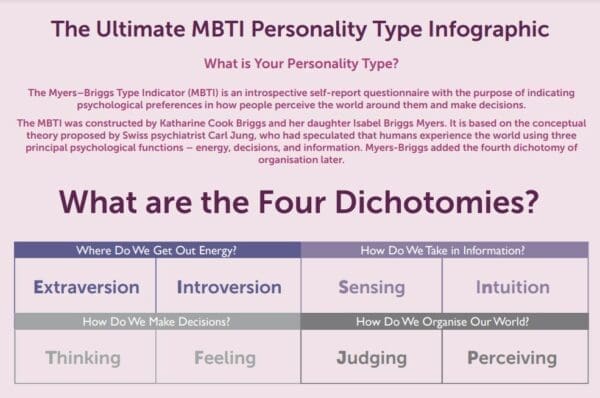‘The Doer’
Which of the below best sums up ESTP in your opinion?
Life is either a daring adventure or nothing at all.”
— Helen Keller
Or
Excuse me for doing my job thoroughly… and with style.”
— Lance Hunter Agents (S.H.I.E.L.D.)
The answer is both.
In this complete guide, you’re going to discover all about ESTPs and their personality type. You’ll learn the best way to build a memorable relationship dynamic with them, develop an advantageous partnership at work or converse with your ESTP clients. Heck, you might even want to go on an adventure with them… And of course, if you’re an ESTP, you’re in for a treat.
But first:
Is ESTP a Rare Personality?
Between 4.3% of the population (5.6% of men and 3% of women) are ESTPs which makes ESTP the seventh-rarest personality type. As one of four artisans, ESTPs are all about realistic ideas and actions. In a world where old structures are being shaken to their core (and about time), ESTPs are at the forefront, practical problem solvers.
Now the question is: how can you embody the best of ESTP and become a better version of yourself? Well, that’s where this complete guide comes into play. You will discover:
- PART I An Overview of MBTI
- Chapter 1 – Development of MBTI
- Chapter 2 – The Rise and Fame of MBTI
- Chapter 3 – The 5 Values of MBTI
- Chapter 4 – The 4 Dimensions of MBTI
- PART II ESTP Meaning
- Chapter 5 – ESTP Personality Type
- Chapter 5.1 – What is an ESTP girl like?
- Chapter 5.2 – Is ESTP Talkative?
- Chapter 5.3 – The Strengths of ESTP
- Chapter 5.4 – The Weaknesses of ESTP
- Chapter 5.5 – Are ESTP Self-centred?
- Chapter 5.6 – Are ESTP Smart?
- Chapter 5.7 – ESTP-a Personality (the 5th Dimension)
- PART III ESTP Compatibility
- Chapter 6 – ESTP and INFJ
- Chapter 7 – ESTP and INFP
- Chapter 8 – ESTP in Love
- PART IV ESTP Learning & Growing
- Chapter 9 – The Development of ESTP
- Chapter 10 – How E & I Complement Each Other
- Chapter 11 – How S & N Complement Each Other
- Chapter 12 – How T & F Complement Each Other
- Chapter 13 – How J & P Complement Each Other
- Chapter 14 – How to Communicate with ESTP
- Chapter 15 – Can ESTP Have Anxiety?
- PART V ESTP Careers
- Chapter 16 – ESTP Leadership Style
- Part VI Fun Facts
- Chapter 17 – ESTP Lifestyle & Hobbies
- Chapter 18 – ESTP Quotes
- Chapter 19 – Famous ESTP People
- Chapter 20 – ESTP Fictional Characters
- Chapter 21 – ESTP Anime Characters
- Chapter 22 – ESTP Action Plan
- Conclusion
PART I An Overview of MBTI
Carl Gustav Jung? Isabel Briggs-Myers? Who’s the founder of MBTI?
While many claim that Katherine Briggs and her daughter Isabelle Myers are the creators of the now-famous MBTI, did you know it was Carl Gustav Jung who came up with the idea first?
MBTI is based on Carl Jung’s work, “the influential theory of psychological types” dating back to 1921. His work talks about preferred types of behaviour with four main functions. The first two functions define the way we perform – how we take information and how we make decisions. The second two functions define our energy or form of expression – extraversion and introversion.
Controversially and contrary to popular belief, Jung repeatedly objected to Katherine and Isabelle’s work, claiming that his work has been misinterpreted.

Chapter 1 – Development of MBTI
Strong with the belief that Jung’s theory on the knowledge of preferences will help women find work, Isabelle Myers with the help and guidance of her mother Katherine Briggs embarked on a journey that led to the birth of MBTI, also known as Myers Briggs Type Indicator.
One of the key advancements the mother and daughter added to the MBTI dimension is the attitude to the outer world and so the birth of a 4th preference came to light.
Chapter 2 – The Rise and Fame of MBTI
In 1970 Isabelle Myers and Mary McCaulley worked together to bring light to MBTI and soon after in 1975, their efforts paid off as it became one of the most used and well-known personality type assessments in the world (even until now).
Chapter 3 – The 5 Values of MBTI
- MBTI can be used for individuals or teams.
- MBTI is a framework to improve self-awareness.
- MBTI is a powerful tool to improve communication.
- MBTI is a tool to develop leadership skills such as problem-solving, decision-making, change management, and teamwork.
- MBTI is a method for identifying stressors and how to manage them.
Chapter 4 – The 4 Dimensions of MBTI
Let’s start our self-awareness journey with the 4 dimensions of MBTI. Here’s a quick checklist to gauge yourself and see where you stand. Reflect on those 4 questions without overthinking (we will cover more in-depth a little later, this is just to get you started).
First Dimension – how do you express your energy: are you an Extrovert (E) or an Introvert (I)?
Second Dimension – how do you process information: are you a Sensor (S) or an Intuitive (N)?
Third Dimension – how do you make decisions: are you a Thinker (T) or a Feeler (F)
Fourth Dimension – how do you like your lifestyle: are you a Judger (J) or a Perceiver (P)
Click on the below for the larger image.

Now that you have reflected, you will notice that the different combination of those 4 dimensions results in 16 profiles which we know as MBTI. Those 16 profiles are divided into 4 different quadrants or families which we call: Rationales (INTJ, INTP, ENTJ, ENTP), Idealists (INFJ, INFP, ENFJ, ENFP), Guardians (ISTJ, ISFJ, ESTJ, ESFJ), and Artisans (ISFP, ISTP, ESFP, ESTP).
While we are born with a certain set of tendencies, we also develop subsequent tendencies as we grow up due to our environment and the experiences we go through.
Example
Take for example someone born with a more dominant extroverted tendency; they can unconsciously develop their introverted tendency due to circumstances in life beyond their control (like an event that triggers shyness in them).
Other times, we can consciously choose to develop a tendency for work purposes. Someone who is a perceiver might want to develop some of the judger’s tendencies to be more productive at work.
One thing for sure is that there is no black or white: extrovert or introvert, sensor or intuitive, thinker or feeler, judger, or perceiver. We all dance in a spectrum between each tendency. Some of us might have more extreme tendencies, that’s for sure.
When we learn a new tendency, we don’t change our nature, we just upgrade ourselves thanks to our environment and upbringing.
A word of caution, if you are living in a constant state of stress, anxiety, and worry, then you probably are acting from nurtured tendencies rather than your natural tendencies. In that case, reverting to your natural tendencies can lower your stress. Once you master both dynamics, you can of course dance between them.
Okay enough with MBTI, you want to know more about yourself, right? Just in case your curiosity is taking the best of you, you can check our ultimate MBTI guide. And if you want to confirm you are an ESTP, you can go through this short MBTI test.

PART II ESTP Meaning
‘E’ for Extrovert, ‘S’ for Sensor, ‘T’ for Thinker, and ‘P’ for Perceiver. That’s short for ESTP meaning.
Why short you might ask? Extroverts generally have a shorter attention span than introverts. ESTP also think on their feet and are pragmatic. So let’s cut it short, give you the juice, and let you go on your merry way. Shall we?
Ready or not, here we go for a deep dive into each of the 4 dimensions of MBTI:
Let’s Begin with the First Dimension – Extraversion
As an extrovert ESTPs gain energy (and feel re-vitalized) by being with people and in external events. Your preferred way of communication is by talking which allows you to work out ideas by bouncing them with people. You learn best by doing and discussing. Contrary to the introvert (your opposite), you have broad interests. ESTP is also sociable and expressive – they over-share personal information and sometimes can invade other people’s privacy (not willingly of course – it’s their way to show they care). As an ESTP, you are a little more reserved and share less than a Feeler type. ESTP often takes initiative regardless of the situation, preferring to interact and connect with people.
Are you really an extrovert? or maybe, just maybe, an ambivert? One of the top organisational psychologists Adam Grant conducted studies that showed that 2/3 of the population are ambiverts. To make sure you know who you really are, here’s a comprehensive article on extroverts by Kendra Cherry you can check.
How Do You Process Information as a Sensing Type?
ESTPs are very much in tune with their senses. They excel at focusing on the details and specifics, always noticing details, remembering facts, and focusing on the small steps and facts. In their process of pattern creation, they notice anything new or different right away, they are that good. ESTPs live in the here and now and are not interested in the future preferring a look at the present and what can be practically done. They trust experience over theories and ideas and enjoy step-step instructions. ESTPs use their 5 senses to take in information.

Let’s move to the third dimension.
Are You Objective or Subjective When Taking Decisions?
It’s decision time for ESTP, the time to remove the rose-coloured glasses, put humans and values aside, and be objective. It’s not that ESTPs are not compassionate, it’s just that it’s easier to leave emotions aside and look at the decision with a black-and-white vision. After all, Henry Ford said it best:
If I had asked my customers what they wanted, they would have said a faster horse.”
That’s how ESTPs think big and objectively. They consider the pros and cons of ideas, information, and opinions. Work harmony and being good with colleagues are not a priority for ESTPs preferring to concentrate on the task at hand. In fact, they can be harsh with their fellow Feelers sometimes (without really meaning it) by giving critiques and quickly looking for errors (instead of improvements). They do have fairness in their dictionary and like to treat everyone equally. One question keeps revolving in the mind of ESTP: “Is this logical?”
And Finally, the Fourth Dimension – Lifestyle.
Why be stuck in a 9 to 5 when you can work from your laptop from anywhere in the world? That could be an ESTP motto. No for tight deadlines, no for strict schedules! Leave me some room for breathing, I’m suffocating. Did anyone order a surprise? Meee.
Yes, ESTPs are perceivers and love it. They enjoy surprises and adapting to last-minute changes. Flexibility is key for their lifestyle, especially when it comes to plans. The most beautiful gift a perceiver can receive is the freedom to be spontaneous. Be careful though, they may run late for meetings.

ESTP’s cognitive functions
ESTPs’ dominant cognitive function is extraverted sensing (Si) which makes them action and sensation oriented. Their auxiliary function is introverted thinking (Ti) which makes them aware of past experiences and facts, disciplined, and observant. Extraverted feeling (Fe) is ESTPs’ tertiary cognitive function which means they rely upon their introverted sensation much more and try to use the extraverted feeling the least possible. Introverted intuition (Ni) is the last (and in this case the least used) cognitive function of ESTPs meaning they base their decision on actions and physical sensations only.
Next, we’ll discover what is an ESTP personality type like in more detail.
Bonus Resource:
You can join our Myers Briggs training course by clicking on the banner below. Finally, learn more tips on how to engage with people of different types of preferences and more!

Chapter 5 – ESTP Personality Type
What do Libras – the energetic risk taker, sales representatives, and branding consultants have in common? They have an ESTP personality type. As an entrepreneur, a stickler for the rules, an adventurer at heart, and an active person, what better way to set your side hustle on your terms?
If your life were a movie, it would be James Bond or Lara Croft. If you haven’t seen those movies, you’re missing out.
You are driven by your sense of action, and you have a special inkling towards experimenting. As an ESTP you are constantly on the go. The perceiver in you makes you flexible and adaptable to change and just like our hero and heroine you are ready for some action. There is no better time for you than the present. As a true Libra, you enjoy the beauty around you and what it has to offer.
ESTPs are always going for the thrill, think fast, and act even faster which can sometimes lead to problems because of their recklessness. But hey, they are fun to be around. With their keen observant skills and fast adaptability, they can shift things around in a heartbeat. Because of their speed, one might think they are insensitive it’s just that they don’t like to delve into the deeper stuff.
They are often those that go after extreme sports, those long-lost hikes in the deep dark mountain, or that 90-day challenge in the desert. We see a lot of ESTPs as athletes – craving extreme physical sensations.

Chapter 5.1 – What is an ESTP girl like?
Being only 3% of the population, some might be relieved since women with an ESTP personality tend to be somewhat different. Others might say “I love the difference.” Remember Lara Croft? She’s not your typical woman, right? She’s adventurous, fun, independent, and a free spirit. If you’re thinking “meh, she’s not real.”, you are familiar with Madonna, right? I’m saying no more.
Like their male counterparts, ESTP females are energetic, outgoing, logical, and spontaneous. They can be your entertainer for a great event or your best friend in your wildest adventure.
ESTP women might have trouble keeping relationships or having good friends due to their fear of intimacy and their insensitivity (to avoid intimacy), but they have a LOT of acquaintances.
Introversion, Intuition, Thinker, and Judger seem more masculine while extraversion, sensing, feeling, and perceiving are more feminine traits. This shows us the most masculine type is INTJ and the most feminine type is ESFP.
In other words, INTJs are the most alpha male and ESFPs are the most alpha female. (Note that masculine and feminine are not referred to as man and woman, but rather as masculine and feminine energies. And alpha male and alpha female refer to masculine and feminine energies). Having said that, ESTP is more of an alpha female.

Chapter 5.2 – Is ESTP Talkative?
Yes and no! What? When an ESTP is surrounded by people, good luck trying to make them stop talking – you may think they swallowed a radio. However, when left to themselves, ESTPS can be very much in their thoughts. Interesting combination, right? It becomes clearer when you take a look at Dr. A.J. Drenth’s study where he describes how extraversion is not the only factor to consider when examining how talkative a personality type can be. In his study, Dr. Drenth mentions other factors such as Intuitives, Judgers, and personality types with an FE (extraverted feeling) function.
ESTP’s Conversations Type would is normally based on the energy they draw from observing the world around them, focused on the strong sensations and concrete experiences they have. Their talks would be objective, measurable, and concrete (they may have invented the SMART goals). One of the reasons that ESTPs tend to be reflective alone and fired up with people is their perceive tendency which may need to be activated by someone or something (contrary to the Judger). Adventurous at heart, ESTP would be talking about their latest experience.
Chapter 5.3 – The Strengths of ESTP
ESTP’s boldness and adaptability give them an unfair advantage which comes in handy in a fast-paced environment – whether in an adventure or a business crisis. Their observant skills allow them to read well other people and think quickly on their feet – they are great persuaders. Another ESTP strength is logic and practicality. If you are familiar with the 6 thinking hats by Edward Debono, ESTPs wear the White hat.
ESTP can be the life of the party and one sure thing, you will never get bored with an ESTP.

Chapter 5.4 – The Weaknesses of ESTP
Let’s go, let’s go, let’s go. It’s great to always be on the go, and decide on the spot, but it can also backfire sometimes – ESTP can be impulsive. One weakness can sometimes lead to another: insensitivity. Because of their logic and factual mind, constantly seeking the truth, they tend to speak in a direct way which can hurt other people. ESTP can be very competitive and while competition is healthy, they take it to the extreme. And what about their unpredictability?
It’s hard to work with ESTPs as they are prone to not following plans. Where do ESTP’s weaknesses come from? The gap between their ideal and reality. Being present-oriented, ESTP get bored of ‘old’ projects, they have already solved it in their minds, haven’t they? That boredom and excitement of new challenges can make it challenging for ESTP to focus. As entrepreneurs, they take the practical matters in hand, and leave the dreaming to others, after all, no one can do everything right?
Chapter 5.5 – Are ESTP Self-centred?
Lo and behold, ESTPs rank number one most self-centred personality types. They can be natural manipulators and ego-centric and when they do, they are insensitive and hurt others. Their ability to look at possible scenarios and read well people gives them a powerful ability to manipulate others. ESTPs do not consider themselves manipulators but rather entitled to what they want (after all they worked very hard). Does this mean that all ESTP are manipulators? Of course not!

Chapter 5.6 – Are ESTP Smart?
History has been very judgmental; you’re only smart if you’re number smart or strategic (or something like that). Engineers and doctors are smart, the rest of the world needs to catch up. Let me tell you something, one of my favorite quotes was said by a certain Albert Einstein (yes ‘that’ Einstein):
Everybody is a genius. But if you judge a fish by its ability to climb a tree, it will live its whole life believing that it is silly.”
Interesting right? Howard Garner, a Harvard psychologist, wrote a book in 1923 about 9 different types of intelligence. NINE! What does this mean for you? What type of intelligence does ESTJ possess? Kinesthetic Intelligence. It was obvious, right?
After all our talk about enjoying extreme physical sensations and of course you being super observant. As such, your favourite way to learn is by doing. You thrive in a fast-paced environment that requires on-the-spot decisions and persuading others. It can also be said that ESTP has practical intelligence.

Chapter 5.7 – ESTP-a Personality (the 5th Dimension)
A for Assertive and T for Turbulent. Assertive ESTPs (ESTP-a) are more assertive and honest than Turbulent ESTPs (ESTP-t). They tend to be bolder and less self-conscious when surrounded by people. On the other hand, they tend to be more insensitive than ESTP-t. They can be better decision-makers on the spot but worse team players. Both ESTP-t and ESTP-a have different responses to stress. In short, the 5th dimension is all about confidence.
And now, let the wedding bells start ringing!
PART III ESTP Compatibility
So, who should the ESTP marry? Who is ESTP’s soulmate? Artisans are most compatible with Guardians. As an Artisan – ESTP have the best flings and passionate short-term relationships with ISFJs, while they have the best long-term lovey-dovey relationship with ESFJ.
As a rule of thumb, it’s important to have a balance of two traits in common and two complementary. The two in common will help you feel at home with the person, and the two complementary will give you the friction to keep the sparks alive. Choosing the right combination to find your ‘almost’ ideal match will depend on your upbringing, your current environment (and if you want to change it), and the goals you want to achieve in life.
Taking the example above, the ISFJ will bring introversion, a more personal way of looking at things which leads to a better and deeper connection, and a more routine life for you and into your relationship. While this combination is intriguing in the short term it can exhaust you in the long haul.
An interesting research showcased how ESTPs are a complex personality type when it comes to dating and relationships. The study explored four different factors for compatibility: communication, passion, friendship, and partnership. This same study shows that whenever it ranked high in one, it ranked lower in another. So what are you choosing? Or rather whom are you choosing?

Chapter 6 – ESTP and INFJ
A question often asked is are ESTP and INFJ compatible. Interestingly, this question shows up high in google when searching for ESTP. It’s interesting because this relationship dynamic is great for a short-term romance or a period of growth. How different do you think ESTP and INFJ are? Take a moment to reflect before delving deeper.
ESTP and INFJ are total opposites. They think differently, relate differently, and work differently, basically, they are very far apart.
ESTP and INFJ are soulmates. Whuut? Yes, they are here to teach each other lessons and to help each other grow. They bring out the best and the worst in each other. ENTP is an extrovert, thinker, and abhors schedules. INFJ is an introvert, a feeler, and craves schedules.
If they are seeking a change in their lives and don’t know how, or if they have been attracting the same type of partner for some time, then it’s a great opportunity for ESTP and INFJ to date.
Chapter 7 – ESTP and INFP
ESTJ are attracted to the depth and empathy of INFP while INFPs are attracted to the reliability and charisma of ESTJ.
ESTJ and INFP are complete opposites in every sense of the word. They live in completely different worlds.
On the positive, ESTJ inspires INFP to go out of their comfort zone and come up with concrete plans, while INFP inspires ESTJ to introspect and be more relaxed with their day-to-day.
Chapter 8 – ESTP in Love

ESTPs are expressive, fun, playful, practical, and spontaneous when in love. They enjoy going on adventures with their partner and when their partner plays along this is a big turn-on for them. Note that they are fun to be around and flirt quite a bit. They avoid serious stuff and tend to get bored easily. This is a physical relationship rather than an intellectual one.
ESTP might want to be cautious if they are dating an introvert as they may inadvertently irritate them. Another point worth working on is about being more emotionally vulnerable as they avoid intimacy at all costs.
A life of love, full adventure, new experiences, and ongoing change drives ESTP insanely in love.
PART IV ESTP Learning & Growing
But first, a little glimpse into how you became you.
Chapter 9 – The Development of ESTP
ESTP just like any other personality type goes through three phases of transformation in their lifetime. Phases can be shorter or longer depending on your nature, the environment you are growing up and developing into, and your career.
The first phase is obviously childhood. As highly charismatic children, ESTPs’ main development at this stage is their extroversion and their sensors. The outside world is like a playground they enjoy messing around in, meeting new and different people, doing extreme activities, and acting on their ideas.
The second phase happens between adolescence and early 30s. This is where ESTP develops their auxiliary function of introverted thinking. Extreme activities will rise here such as joining the marines or starting a music band.
The third and final phase of development for ESTP is the integration phase. This is where all the pieces of the puzzle click together.

Chapter 10 – How E & I Can Help Complement Each Other
Extroverts can help introverts open their sphere of influence by:
- Moving into action
- Broadening their ideas
- Amplifying their energy focus
- Expanding their Interaction
- Widening their network
- Providing extensive information
Introverts can help extroverts centre themselves by:
- Reflecting more
- Scanning through ideas
- Deepen their calmness
- Strengthen their concentration
- Deepen their friendships
- Listening to others
Chapter 11 – How S & N Can Help Complement Each Other
Sensors can help intuitivist be more practical by:
- Adding more facts
- Providing more practical and realistic information
- Looking deeper at the details
- Applying their experience when solving problems
- Focusing on what needs attention now
- Focusing on the present
Intuitive can help Sensors recognise the inter-connectedness by:
- Looking at new ideas
- Creating change
- Being open to looking at trends
- Applying insight and pattern recognition to solving problems
- Focusing on long-term goals instead of short-term goals
- Focusing on future possibilities
Chapter 12 – How T & F Can Help Complement Each Other
Thinkers can help Feelers get clearer and more direct by:
- Analysing the implications and consequences
- Being consistent with rules
- Standing firm on important principles
- Being more objective when making decisions
- Having specific criteria that allow a clearer thinking process
Feelers can help Thinkers reconnect by:
- Predicting how others will react and feel
- Making individual exceptions when necessary
- Accepting human-centred values
- Allowing better cooperation and collaboration
- Creating a more harmonious environment
Chapter 13 – How J & P Can Help Complement Each Other
Judgers can help Perceivers be more productive by:
- Being more organised and decisive
- Sharing decisions and moving ahead
- Being in control
- Having closure
- Focusing on tasks and goals
- Providing clear expectations and timelines
Feelers can help Judgers be open to possibilities by:
- Being more flexible and adapting better
- Dealing with situations as they arise
- Embracing new experiences
- Being open to options
- Being open to new information
- Accepting change
Great points, right? Now, as an ESTP, your opposite would be INFJ. I’d like to invite you to choose one point of each of your opposites (that makes 4 points) and develop them, making them part of you.
Chapter 14 – How to Communicate with Your ESTP Manager, Colleague, or Romantic Partner
Do you want to get the most out of your ESTP colleague/employee/boss, or romantic partner? It’s simple, just act as they would, and they will love you for it. So much that you will see their productivity skyrocket, their affection for you increases, and more.

The 5 ESTP Rules for the Introvert (rule 0: let’s connect)
- Show you are listening by acknowledging and hinting you are preparing an answer.
- Try using your body language to express your interest and enthusiasm such as leaning forward, nodding, smiling, and most importantly eye contact.
- Be ready to share more information (others would want feedback).
- Take initiative sometimes and introduce yourself or start a conversation.
- Expect not well-thought words as extroverts think out loud.
The 6 ESTP Rules for the Intuit (rule 0: dream a little, you are allowed)
- Provide step-by-step, detailed information on specific tasks (share the facts before giving the big picture).
- Provide as many concrete facts and examples to prove your ideas (and I mean to be super generous).
- Share more facts and observations (tables, graphs, infographics, they are all welcome).
- Be organised in your presentation, and sequentially present your thoughts and findings (don’t just share links and ideas).
- Remember that others might not seek change – be open to sticking to a plan.
- Assess what is working well as well as what needs to be changed.
The 6 ESTP Rules for the Feeler (rule 0: people buy emotions, not facts)
- Take the time to get to know ESTPs and develop a rapport with them.
- When you are listening, avoid criticism.
- Remember to be friendly and offer support and encouragement.
- While honest feedback is important, remember to provide it gently and to critique the behaviour instead of the person – acknowledge don’t analyse feelings and values.
- While focusing on your tasks and objectives, remember that individuals are also involved in the situation – adding a personal touch would go a long way.
- Focus on creating a win-win situation, not everyone likes competition.
The 5 ESTP Rules for the Judger (rule 0: “There is no shred of evidence that life is meant to be serious.” Unknown author)
- Before taking decisions, explore alternative opportunities.
- To make sure the project goes to completion, discuss, and establish a timeline together with the ESTP instead of just giving them a deadline – that way it looks as if the deadline is intrinsic rather than forced upon them.
- Avoid making quick decisions and rather seek additional information before taking a decision.
- Try to be open to change – whether the situation, the dynamic or even the plan.
- Set your perfectionism aside and be willing to take a few steps even if your master plan is not ideal yet.
Chapter 15 – Can ESTP Have Anxiety?

Remember how we mentioned that ESTP can be super talkative or radio silent? When they are anxious, they go radio silent. They cave or withdraw and can feel overly suspicious. One way they become anxious is because they overwhelm themselves by doing many things at the same time just to reach their goals and overcome challenges. ESTPs might want to take a book out of Oprah Winfrey and focus on one thing at a time as multitasking is not a good thing – especially with regard to anxiety. So yes, ESTPs have anxiety just like the rest of us, they are human after all.
Do you know what else stresses ESTPs?
The 5 Stressors Linked to their Extroversion:
- Working by themselves
- Communicate by email most of the time
- Intense focus periods with no breaks
- Having to reflect before action
- Focusing on one thing at a time
The 4 Stressors Linked to their Thinking:
- Adjusting to personal preferences and needs
- Focusing on the positive of a situation
- Making decisions based on values and empathy
- Answering questions that seem inappropriate
And if you are an ESTP struggling with anxiety, try to meditate and do breathing exercises to lessen your overthinking, or better yet go for an intense physical activity.
Up for a challenge? I would like to invite you to work on one of the points mentioned so that you are in control of your stressor rather than them controlling you. And remember that “Rome was not built in a day.” Take it one bite at a time. And every time do one smaller step.
PART V ESTP Careers
ESTPs thrive in a career that offers flexibility, different day-to-day, and a fast-paced environment where quick decisions must be made. They rely on facts and experience. In whatever career they find themselves in, ESTP will put forth their kinesthetic intelligence with their body. With that in mind, here are a few ideal careers for an ESTP: Fitness instructor, lawyer, firefighter, chef, entrepreneur, sales manager, paramedic, building contractor, actor, flight attendant, athlete, or financial advisor. You can also check this more comprehensive career list.
Fancy any of those roles?

As an ST, your main strength is making quick decisions and acting upon them when crises happen. It’s all about taking action. You solve problems and make decisions using your ST functions (remember the 5 values, which will go a long way to know your ESTP career path).
With S you tune in to facts, and sensors, and seek practical actions related to the problem. With T you see where the decision fits with the vision and the systems of the organisation and assess the effect on both, and then you determine how to act to get to your solution.
Chapter 16 – Leadership Style
The adventurous leader. Practical, entrepreneurial, present thinking. ESTPs are more task-oriented at work and might brush aside team spirit. As would do a typical entrepreneur.
Empowered by your actions, quick thinking, and flexibility you are among the most influential leaders, and you tend to attract a special crowd of people with your handling of crises. Your quick thinking and quick action are music to your followers who loves the challenge and progress.
Some ESTP might take their strengths to the extreme which would turn them into their weakness. While it’s great to act fast, it’s also important not to be too impulsive. We might hurt others sometimes or make mistakes. One way to overcome this challenge would be to surround yourself with an intuitive and judging team that will help with the vision and planning.
Part VI Fun Facts

Chapter 17 – Lifestyle & Hobbies
Everything extreme, from extreme sports to extreme adventures, as long as it’s physical and a challenge to be solved NOW, ESTPs are in. Donald Trump’s “You are fired” resonates best here. In their downtime, you can spot an ESTP cycling, kayaking, networking, attending events, learning a new language, or anything adventurous really.
Chapter 18 – ESTP Quotes
Remember how ESTPs need someone or something to light up a fire under them? Well perhaps one of these quotes will do the trick:
If they say, “It’s impossible,” remember that it’s impossible for them, not for you.
“You have enemies? Good. That means you’ve stood up for something, sometime in your life.” – Winston Churchill
“The world needs dreamers and the world needs doers. But above all, the world needs dreamers who do.” – Sarah Ban Breathnach
“Success is not the result of spontaneous combustion. You must set yourself on fire.” – Reggie Leach
“Action may not always bring happiness, but there is no happiness without action.” William James
“Never tell me the odds!” Han Solo (Star Wars)
Chapter 19 – Famous ESTP People
My favourite ESTP is Jack Nicholson (Actor). Other notable ESTP mentions are Meryl Streep (Actress), Mila Kunis (Actress), and Winston Churchill (British Prime Minister).
Would you rather choose Donald Trump or George W. Bush (Former Presidents of the USA)? Take a look at PersonalityMax for other famous ESTPs.
Chapter 20 – Fictional Characters
My favourite ESTP character is James Bond (James Bond). My second pick would be a tie between Sirius Black (Harry Potter) and Bart Simpson (The Simpsons). Do you agree?
Chapter 21 – Anime Characters
What about ESTP anime characters? Definitely: Melodias & Ban (The Seven Deadly Sins), Tsunade (Naruto), Master Roshi (Dragon Ball), and Taiga Kagami (Kuroko’s Basketball). What about you?
If you don’t resonate with them, take your pick with the ESTP Personality database. They have a comprehensive ESTP famous and fictional characters list for you to look at. And one of them might surprise you!
Chapter 22 – Action Plan
Now that you know yourself better, let’s help you step into the world, your new world, with an action plan. Let’s make sure that you are the best version of yourself. We at Making Business Matter strongly support personal and professional growth.

As a manager, colleague, or partner working in the UK groceries industry as a supplier, we want to help you by giving you an action plan specially created for ESTP supply managers working in the UK.
In our free guide, you will learn about work-based activities, receive a roadmap for line managers to support their teams, and our 5-level evaluation (chain of evidence) to show the ROI of our training (they stick!).
Stop everything you are doing and act now. Whether you are at work or home, ask the people you are surrounded by to do a small project with you for the next 10 minutes. It can be anything, from designing a marketing campaign to cleaning a room. The key here for them is to divide the teams into two groups: extroverts and introverts. Your goal is to observe. After you do the exercise, send us a LinkedIn message to receive feedback.
Conclusion
ESTP seeks External Realism. ESTP seeks Action. They are charismatic supporters of ideas and possibilities.
In this complete guide you discovered MBTI in general, its purpose, and the value it brings to you personally and in the workplace. Also, you discovered the ESTP meaning, your character type, your partner’s ESTP personality type, or your colleague’s ESTP character. You found out what is an ESTP girl like and if ESTP is talkative.
Intimately, you know ESTP: strengths, weaknesses, whether ESTP are self-centred, if ESTPs are smart, how to communicate with an ESTP to get the most out of the relationship, can ESTP have anxiety, the ideal ESTP compatibility, and what and how to develop to become the best version of yourself. You found out about the 5th dimension (ESTP-t and ESTP-a), ESTP famous people, ESTP anime characters, ESTP fiction people, took the ESTP test, ESTP careers and leadership style, the compatibility between (ESTP and INFJ) and (ESTP and INFP), and even some ESTP quotes.
Send us a message on LinkedIn, and we’ll send you The Negotiation Magic P.I.L.L. and a 15-min Strategy Call for ultimate negotiation tactics (no fluff, only making business matter).




